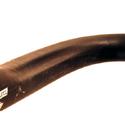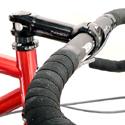
Recently on Cyclingnews.com |
On test: Reynolds Ouzo Pro Anatomic carbon road handlebar, January 5, 2006
An unfair advantage
Having access to worldwide leader in carbon fibre design and construction, one could say Reynolds' products have an unfair advantage. But James Huang wasn't complaining too much after putting its Ouzo Pro Anatomic carbon road handlebars to the test.
Unbeknown to most, Reynolds is actually a division of MacLean Quality Composites, the world's largest supplier of carbon fibre bicycle frame tubing with such big name clients as Calfee, Parlee, and Seven Cycles. In addition, MacLean is a worldwide leader in carbon design and construction for non-bike industries include marine and automotive. With that kind of pedigree, Reynolds Composites have a bit of an unfair advantage over much of the rest of carbon road bar market when it comes to playing with the black stringy stuff. To our benefit, they've put all of that carbon fibre know-how to good use in their Ouzo Pro Anatomic oversized carbon road handlebar.
Where's my fancy carbon fiber pattern???
Sorry, no fancy carbon weave look to be found here. At first glance, the Ouzo Pro Anatomic doesn't even look like a carbon bar with its matte black finish more akin to a shot peened aluminium bar. Instead, Reynolds uses unidirectional fiber plies throughout the bar to maximise the material's efficiency with woven material used only in the stem clamp area for added resistance to clamping stresses. Apparently, Reynolds puts the emphasis on "go" rather than "show", and you'll hear no complaints from me on that one.
In addition to the unique layup, Reynolds actually use three separate bladder molds for this bar instead of one big fat one: one for the top section and one for each drop section. According to them, this not only gives them more manufacturing control over each section, but it also allows them to alter the design in a modular fashion. As a result, their Ouzo Pro bar is actually available in two different styles: the "Anatomic" with tops that gently arc forward and down away from the rider as it exits the stem, and the plain-old Ouzo Pro with more conventional straight tops.
Reynolds provided the Anatomic model for testing here, but both models incorporate an oversized 31.8mm stem clamp diameter, mildly teardrop-profiled tops for a comfy grip, and a complex radius bend in the drops that provides an ergonomic fit without overly restricting your hand position or jacking up the reach to the brake levers as some bars do. Reach is set at 84mm and drops are a moderate 142mm (c-c for both). Our 44cm (c-c) test sample weighed in at a very respectable 232g.
Getting these suckers on
The first thing I noticed when installing these bars was that the matte finish provided a better-than-average purchase in the stem. Even with the additional surface area that an oversized clamp provides, I have found all too many carbon bars that just won't clamp securely, no matter what. This invariably results in the oh-so-annoying "POP" and subsequent downward rotation if you're on the hoods and smack a pothole. Our test bar, however, held on plenty tight in the Thomson X2 stem to which it was installed. The complex radius bend allows for a healthy range of lever positioning and Reynolds provides cleanly laid out and extra-wide housing grooves for the Campyphiles among you.
Hitting the road
It's impossible not to notice the somewhat odd angle of the Ouzo Pro Anatomic tops. Most bar manufacturers that have addressed the wrist angle thing have chosen to sweep their tops back a bit rather than forward, but Reynolds seems to think their way makes more sense. True, it does force your elbows out a bit and opens up the chest for a little better breathing, but it also feels a little weird. Unfortunately, this was not a sensation that I was ever able to get used to. The teardrop shape of the tops, though, was just about the perfect circumference for my moderately large mitts and they seemed to fit equally well in a wide range of angles.
Riding in the hoods was plenty comfy, but I must say that riding in the drops, in particular, was great. The moderately ergonomic bend was comfortable even on lengthy sections of dirt roads and pockmarked pavement (thanks, M-DOT) and I was able to find a number of positions which worked well. Ironically, the forward sweep of the tops was actually helpful when riding in the drops as it provided a smidge more forearm clearance.
Handlebar rigidity is better determined by an objective lab with the proper test equipment (Mark, are you reading this?), so I won't bother to comment on it here other than to mention that the Ouzo Pro Anatomic felt plenty stiff in every situation but still provided that nice level of vibration damping for which carbon is so renowned. To my benefit, I wasn't able to test the handlebar's reliability, but having the Reynolds name emblazoned on the bar lends a good amount of confidence.
Yea or nay?
Reynolds have certainly put their unfair advantage to good use here. I found the Ouzo Pro Anatomic bar to be an excellent bar overall, other than the forward sweep. Perhaps I've ridden too many bars with backswept tops or I'm just shaped funny, but it didn't work for me. Otherwise, the rest of the bar was fantastic and the quality of construction was top-notch. Additionally, the weight was certainly competitive at this price. If you can, try out the Anatomic version to see if it'll work for you, particularly if you ride in the drops a lot. Otherwise, the non-anatomic Ouzo Pro may be a better fit.
Suggested retail price: US$239
Weight: 232g (44cm c-c)
Pro: Outstanding drops, excellent build and finish quality, nice grippy
surface texture
Con: Forward sweep of the "anatomic" tops just weren't for me
More information: www.reynoldscomposites.com
Cyclingnews rating: ![]()







